Entries in Finland (7)
Friday Photo Favorite: Snow is Coming...
 Friday, October 26, 2012 at 22:10
Friday, October 26, 2012 at 22:10 If the forecasts are correct, tomorrow we'll have our first snow of the season.
Luckily our building turned on the heating yesterday, so we're now prepared. I'd love to have a couple of these guys to snuggle up with, though!

 Frau A ...
Frau A ...  Post a Comment
Post a Comment  Friday Photo Favorites tagged
Friday Photo Favorites tagged  Finland,
Finland,  dogs,
dogs,  sled dogs,
sled dogs,  winter ...
winter ...  Print Article
Print Article  Email Article
Email Article  Share Article
Share Article Friday Photo Favorite: Puppies!
 Friday, May 4, 2012 at 0:32
Friday, May 4, 2012 at 0:32 I'm so tired right now and a bit stressed out. Trying to get everything done before deadlines next week.
For anyone else who's having a rough week....PUPPIES!!
Cute, fluffy sweet Husky puppies.
I feel better already.

 Friday Photo Favorites tagged
Friday Photo Favorites tagged  Finland,
Finland,  dogs,
dogs,  photography,
photography,  sled dogs ...
sled dogs ...  Print Article
Print Article  Email Article
Email Article  Share Article
Share Article Ice (wall) Climbing in Finland
 Tuesday, June 21, 2011 at 22:29
Tuesday, June 21, 2011 at 22:29 We've posted already about our Winter Adventure in Finland -- building an igloo, snowmobiling, and sampling local liqueurs. Another highlight was trying ice climbing for the first time.
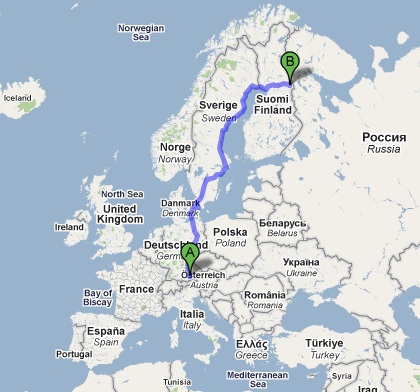
Of course, one side-benefit was learning (and using) new gadgets! In this case, we needed to attach crampons and learn to use an ice axe. I had used crampons before while ascending Mt. Kilimanjaro, but they were not of the ice climbing variety. The ones below are much larger and sharper - easy to rip a hole in pant legs if you misstep. The ice axe was hard to use correctly -- most people swing it too hard and not quite at the right angle. It requires much less power than you think to work. You'll see it in action below...
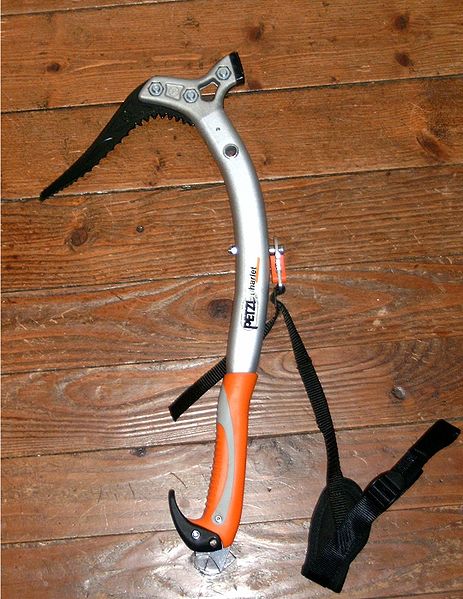
Here we are ready to go with crampons, helmet, and harness. The harness is used for belaying as with rock climbing. Don't be fooled by Frau A's pretty pink hat -- she was was one of the strongest climbers that day!
The "class" took place right at basecamp. They have a climbing wall for summer, and create the ice face for winter. Their web page does not give its height -- maybe 10 meters (30 feet)?
Here I am getting started. We're not experts, but can tell you that the idea is to do most of the work with the legs. The ice axe is used mostly to keep you on the wall -- in effect, you reach up and stab with the axe, plant one foot higher, and simply step up (then bring up & plant the other foot). Rookies like our group send a lot of ice shards down below (need the helmet), but the instructor let the equipment do the work and could really move up the wall smoothly.
Here is Frau A, about halfway up (left photo)... and then at the top! (right photo) Once up there, the instructors let you pause to take in the view -- looking back over your shoulder to the frozen lake where we had made the igloos.
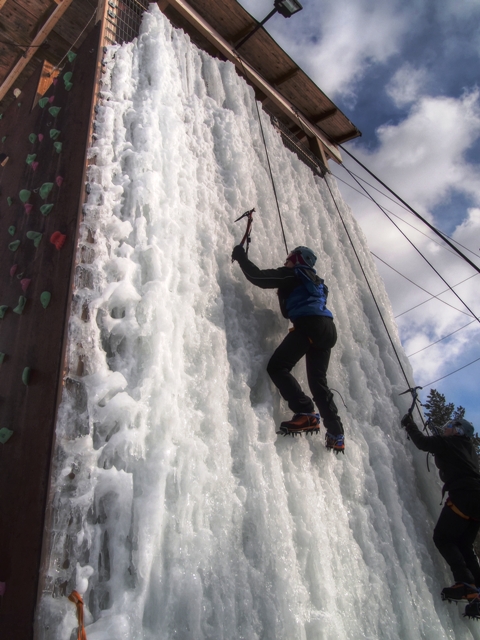
Frau A is clearly enjoying the success and the nice view! After a pause, you lower your arms (with the two axes), lean back almost 90 degrees to the wall, and "walk" down. Fun! It's quite a workout -- using lots of muscles not needed at the computer desk. Forearms were the hardest hit, gripping the axes all the time.
It was a great couple of hours and everyone in our group of five had a blast. However, even after a number of climbs you still don't feel truly comfortable with the equipment / navigating up the ice. None of us are ready to go ice climbing for real. But it's a start. Maybe we'll try a wall this summer and see what happens.
 Herr J ...
Herr J ...  Post a Comment
Post a Comment Basecamp, Finland style
 Sunday, June 5, 2011 at 8:00
Sunday, June 5, 2011 at 8:00 We have already posted a bit about our winter week adventure in Finland, with highlights such as building an igloo and going snowmobiling (with more posts to come, including sledding with huskies!). This post will briefly cover the "basecamp" aspect, with some unique Finnish drinks...
We stayed at "Basecamp Oulanka". This is a small collection of lodges just outside Oulanka National Park. The park sits on the border with Russia, a few kilometers south of the Arctic Circle.
One gets here through Kuusamo airport. Locals say "Welcome to Lapland" but Kuusamo is technically part of Oulu province (on it's northern edge) just below the formal province of Lapland. On the map above, the rest of Finland above Kuusamo is all Lapland province and the cultural region extends into Sweden too.
Basecamp sits on a small rise, perhaps 100m from the shore of a lake. Two 2-story buildings house the guests -- each building has only 8 rooms (you see the top story in the left photo, below). Every room has a balcony that looks into the forest towards the lake.... although you can't see water in Winter.

The central building functions as the equipment center and "lobby" facility. In Winter, each guest heads to the lower level to be issued warm boots, socks, fleece long underwear, snow pants, heavy jackets and gloves. The upper level has the camp reception, kitchen, and a common/dining room.
The photo above/right is from breakfast -- everyone is decked out and ready to go. In the evening, however, things get more relaxed and move in front of the fireplace! It's a nice stone hearth with plenty of room to put your feet up after a tough day in the snow.
Frau A and I like to try local fare, and around the fireplace it seemed appropriate to get to know Finnish drinks.
The first is from a company called Jellona.
Jellona make two kinds of schnapps -- one flavored with anise (the signature flavor in black liquorice) and the one pictured here that is flavored with tar. Yes, tar. Notice the barrel on the label?
It has a strong, smoky, "tarry" (how else to describe it?) character. Definitely puts hair on the chest. A number of people in our group gave it a shot... not the crowd favorite after that. Perhaps it's an acquired taste?
The anise version was more predictable - those that like black liquorice flavor loved it, those that don't, didn't. Frau A said that her father would probably really like the anise version...
Another evening we learned about Finnish cut brandy. Our guide (who doubled as bartender) explained that in wartime, brandy was in short supply so Finns would cut it with vodka.
One star indicates one part brandy to two parts vodka (1/3). Three stars means three parts brandy to one part vodka (3/4, a higher quality).
We tried a one star variety. Not bad. The mix is strange at first, but it works. I'll bet most people would prefer this to straight vodkas.
Jaloviina is a popular brand -- Wikipedia's photo for cut brandy, plus a Facebook page!
Wikipedia notes that vodka-cut-brandy is also common in East Germany as general practice. Interestingly, these versions are not graded -- must be the Russian influence, because Germans tend to control products closely.
I've seen Goldbrand (a German version) in stores and may have to try it. One could cut their own as well...
Finally, we sampled the Lapponia brand of Finnnish liquers.
These are sweeter and thicker than schnapps, with some unique flavors too. We tried cloudberry (not bad!) but blueberry, lingonberry, and buckthorn are also available!
We brought a bottle of cloudberry back (actually, Frau A snuck it home and surprised me for my birthday). In addition to apertif format, we will try it as an ingredient with desserts too.
At the end of each day, most people were quite tired from whatever activity kept us romping through the snow for hours, and after a hot meal & drinks we were content to enjoy the sunset. It seems to be a great options for Summer vacation too, with white water rafting. We'll see...

 Herr J ...
Herr J ...  3 Comments
3 Comments Snowmobiling in Ruka, Finland
 Sunday, May 29, 2011 at 9:00
Sunday, May 29, 2011 at 9:00 On our recent winter adventure in Finland (Oulanka National Park, near Kuusamo), Frau A and I did more than just hang out in our self-built igloo -- we went snowmobiling, too!
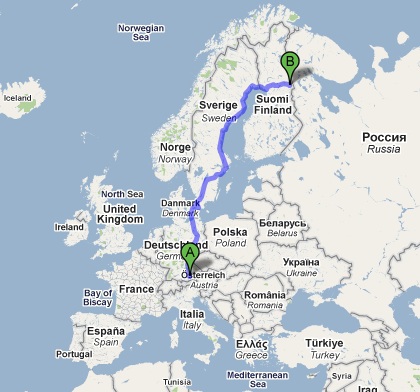
Snowmobiling obviously is not allowed inside Oulanka National Park. Therefore, we rode about 1 hour to the resort town of Ruka (full name is Rukatunturi). Ruka is not an Alpine-level ski resort; the mountain rises to only 490 meters. But it's the best downhill option around! A Finnish ski jumping team was practicing while we were there and I grabbed this shot from afar:
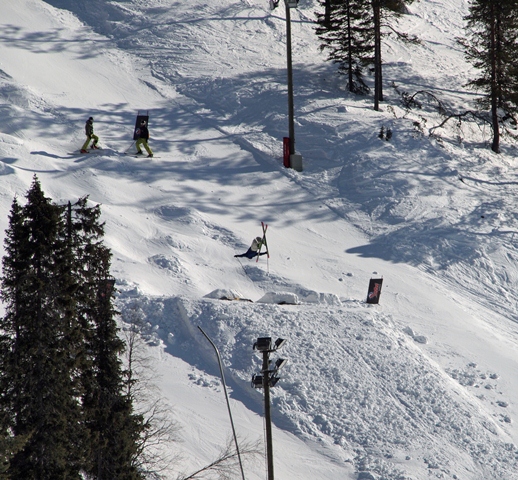
For snowmobiling, however, Ruka offers 600km of trails of which 100km are private routes maintained by the rental/tour companies. We went on one of these "snowmobile safaris".
To start, you need to get outfitted with the right gear, and this means snowmobile suits. It reminded me of my winter attire as a kid, playing in the snow of western New York State. Here is Frau A all decked out, including the helmet and thick mittens. (Mom -- got any old pics of me in a snowmobile suit for comparison???)
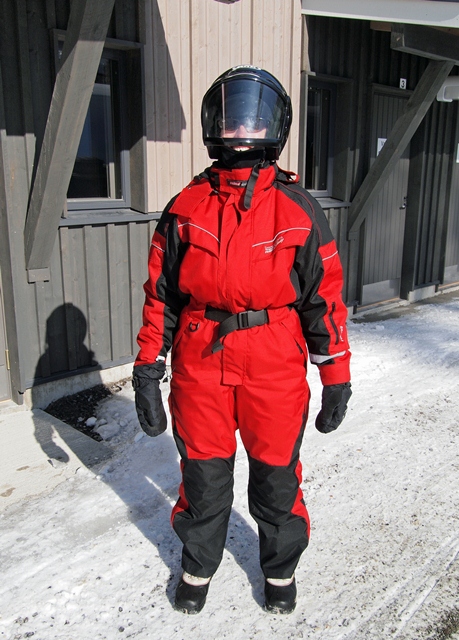
We were lucky enough to use relatively new smowmobiles. In fact, these models have a 4-stroke engine (vs. 2-stroke), are more fuel efficient, and have lower emissions. (Finlnad's tour companies are very vocal about their eco-conservatism.) We took turns driving. Here is Frau A ready to hit the gas:
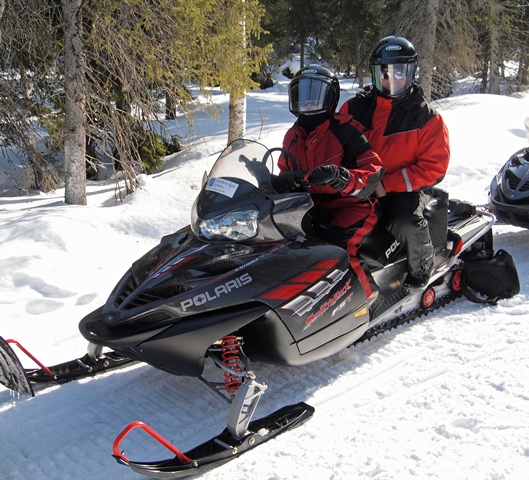
We spent a little time on a warm-up track (for people to get used to driving) and then hit the trails through the woods. Beautiful scenery (but could not take photos while riding). After 45 minutes, we reached something just like an Alpine hut. You know this is a winter country when you get specific parking spots for snowmobiles!
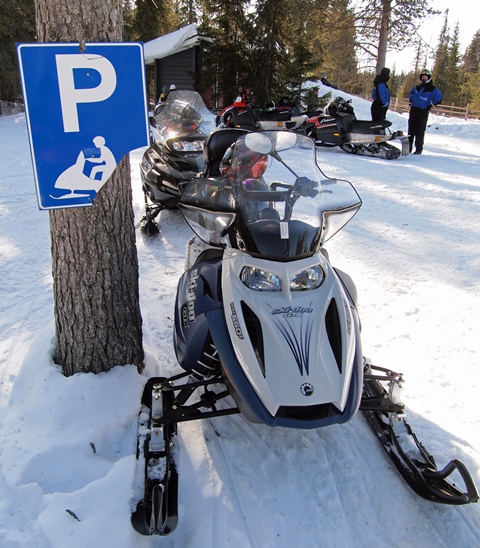
The hut and the weather were perfect. We grabbed a snack (something like a sugar doughnut) and a hot drink, and relaxed at outside tables:
Notice that the seats had reindeer pelts covering them! They weren't needed with such beautiful weather, but deeper in winter they would be a welcome warming device.
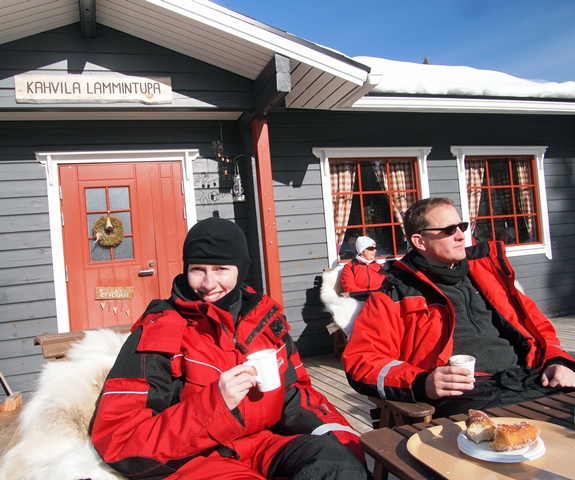
After finishing the refreshments, we could explore the area a bit. It turned out that this was an entire family entertainment complex. Options included...
1) Reindeer petting (Santa would not need them for another 9 months)
2) A circular sledding ride (I have no idea what it's called in English, "sled-go-round" or "sled carousel"? Some sites claim it translates as "pole sleigh".). One end of a long lever is pushed -- the sled at the opposite end is further from the fulcrum and therefore has a higher linear velocity... it feels fast. Kind of like a small carnival ride. Kids loved it. Here's the Finnish Wikipedia entry for those interested.
3) Mini-snowmobiling for children! The machines are powered by what was effectively is a small lawnmower engine. Wish we had these when I was growing up!
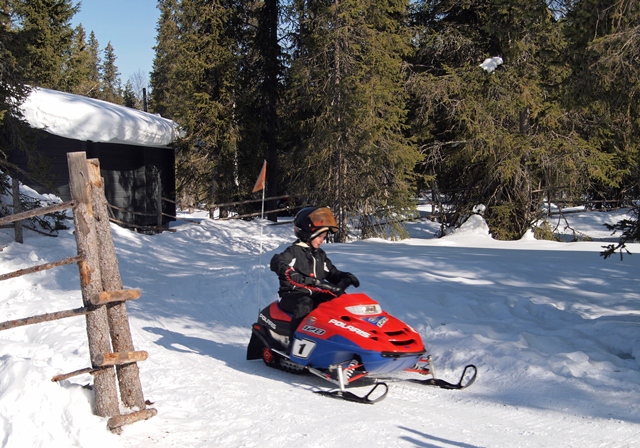
Once the break was over, we circled back on another trail through the woods to the starting point. We turned in our gear and headed into the small "downtown" part of Ruka to see the shops and have some lunch (resturant entrance below).
Yeah, this was a little less true-to-nature than most of our activities in Finland, but it was great fun.
 Frau A ...
Frau A ...  Post a Comment
Post a Comment How to Build an Igloo
 Tuesday, May 17, 2011 at 9:00
Tuesday, May 17, 2011 at 9:00 Late in 2010, Frau A and I had scheduled a vacation to Japan for the Spring of 2011. Unfortunately, a couple weeks before our scheduled departure, Japan was struck by the Great East Japan Earthquake and resulting tsunami.
So we had to cancel the trip, but send best wishes that the recovery and rebuilding process continues successfully -- we can't wait to visit in the future.
Given the last minute options, we decided to have one more winter adventure... in Finland! We went all-in, flying to Helsinki and then on to Kuusamo, which is only 37 miles (60 kilometers) below the Arctic Circle. The specific destination was a small site called Basecamp Oulanka, just outside Oulanka National Park.
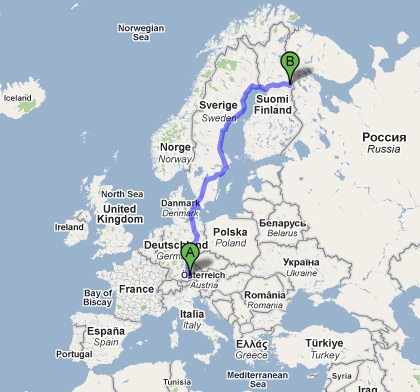
We'll have many more posts on our vacation, because each day we did a different winter sport or activity including ice climbing, snow shoeing, cross-country skiing, and more. But on the first day, we built an igloo and slept in it that night!
Here's how it went...
Step "0": Get some up-front instructions from the local guide. Of course, the rough-sketch diagrams are drawn in the snow (a "Finnish whiteboard," if you will). He described the end result and process to get there. One interesting aspect is that the entrance should start right on the ground, but then have a small "step" up to the sleeping area. The sleeping area should be a foot above the ground so that cold air does not easily flow into the structure.
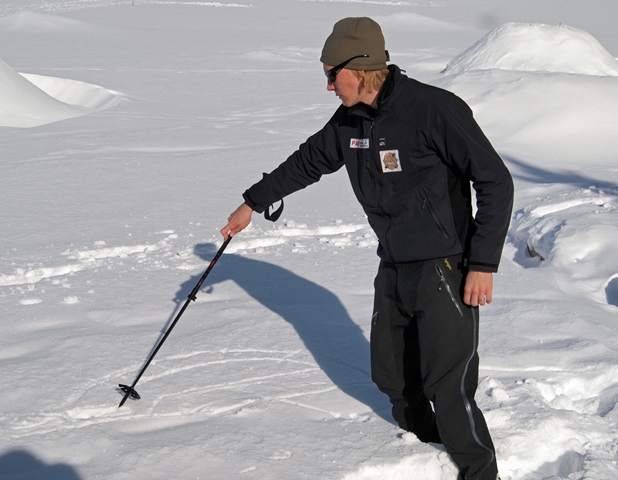
Step 1a: Start shoveling snow into a big pile. A lot of it. Because the temperature was so low, the snow was still "crisp" rather than wet. Therefore we were not using blocks to build the igloo (that's another technique) but rather piling the snow and (later) digging out the inside. The diameter of the dome's base has to be enough to fit the number of people you expect to squeeze in there. In our case, we planned to sleep four people.
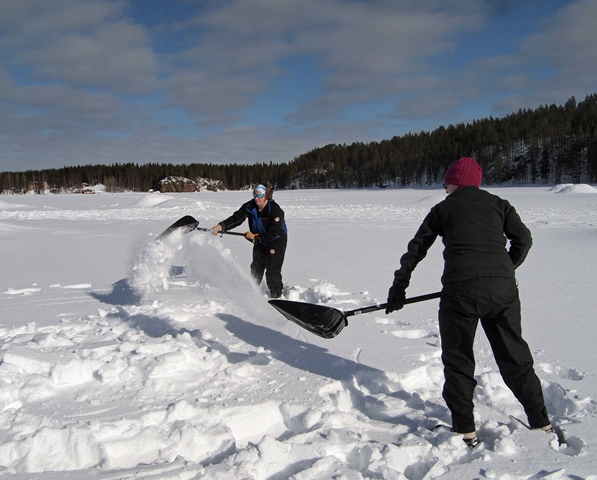
Step 1b: Keep shoveling... Even with four people working hard, it took us three hours to get the pile head-high. Luckily, the sun was out (beautiful weather, actually). It's hard to see here, but we are making the igloo on a frozen lake -- on top of ice a meter thick!
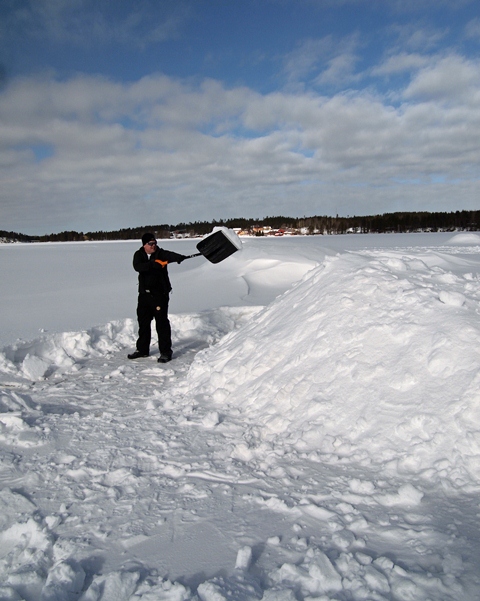
Finally finished with the snow pile! Here is Frau A, triumphantly posing atop the mound that theoretically would house four of us overnight...
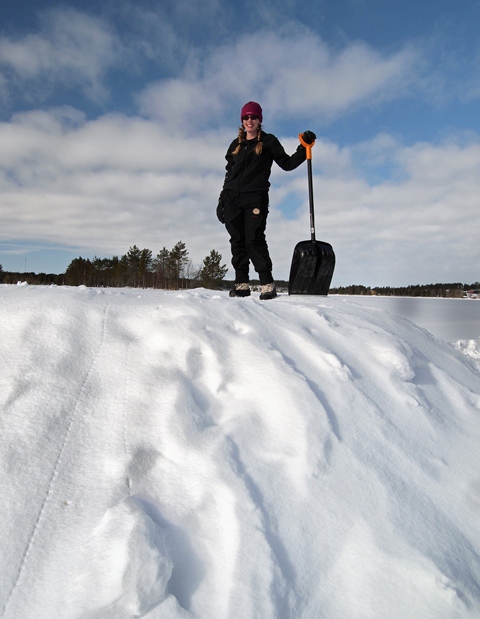
Step 2: After you've patted down the snow pile (to remove air pockets), insert ceiling markers. The ceiling of the igloo ideally should be about a foot thick. This is the right thickness for strength, but not so much mass that there is a danger of it collapsing. So, while the snow is still freshly piled, we took wood pieces about a foot long and inserted them into the dome, about 2-3 feet apart. (Maybe 30 in total, around the entire dome) Later, when digging out the inside, we will stop when reaching these markers and automatically have the right ceiling thickness.
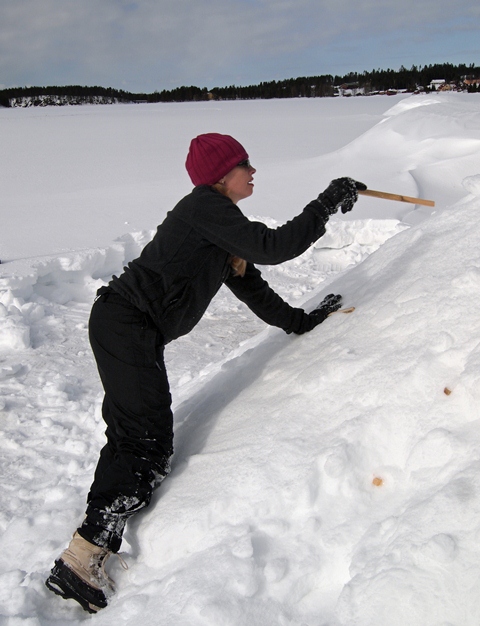
Below is Frau A inserting more ceiling markers. Because you have to have them everywhere, you must climb on top of the pile too. That's OK, because we need it to settle down and this just helps the compacting process.
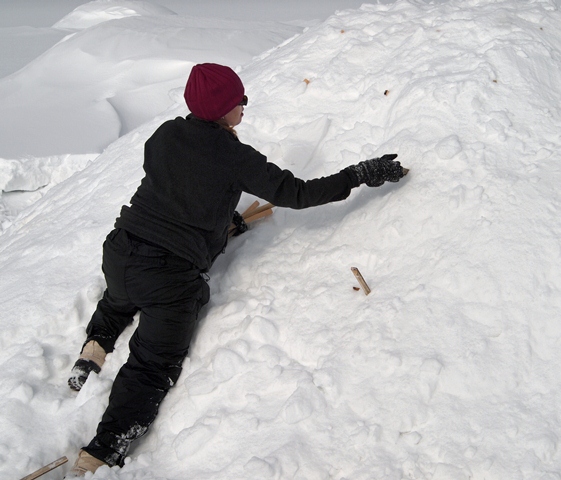
Ta daa! The pile of snow is now complete, the ceiling markers are inserted, and you are officially tired after 3+ hours of work. This is what it looks like:
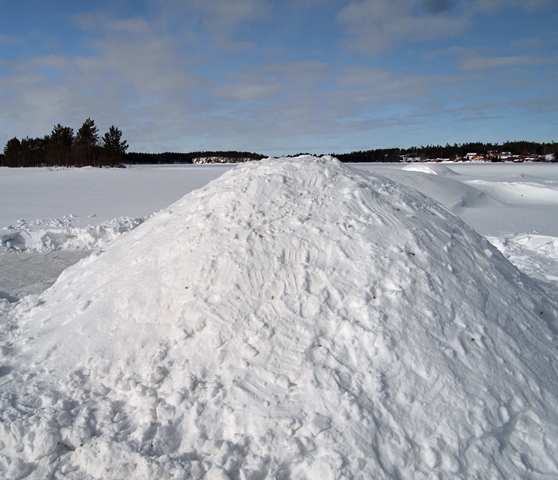
There were a few other small groups with us on the adventure trip, and human/competitive nature dictates that we spy on them and see what and how they are doing... (Note: all the other piles are old igloos from vacationers in the previous months. Still there, and still holding strong.)
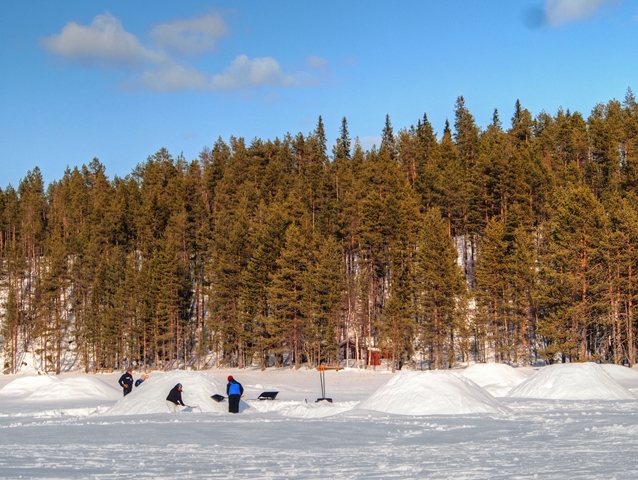
We were a little ahead of the other group (our South African and British partners shoveled snow like machines) so we decided to add some creature comforts... a snow bench outside! We're hoping it increases the resale value, of course.
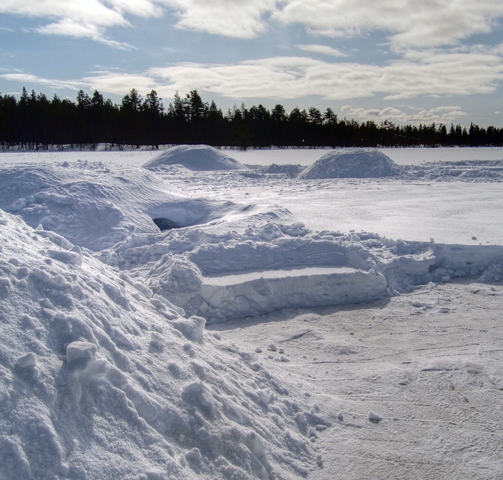
Step 3: Wait. You need to let the snow settle for a good 3 hours. Fortunately, the sun was strong and that warms the snow and helps it compact. In this time, the entire group went show-shoeing along the local river. (In Summer, vacationers go white-water rafting here.) Here are Frau A and I taking a photo stop along the snowshoe hike.
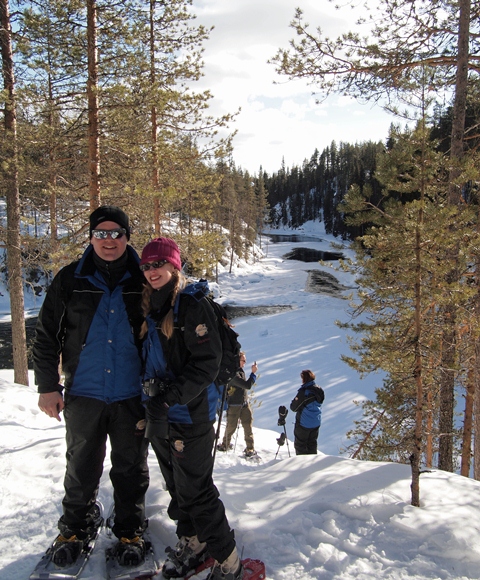
Step 4: Dig out the inside. It's now later in the afternoon and it's been a pretty active day already, but we took another 3+ hours to finish the structure! Naturally, an experienced Finn could probably do the equivalent work in half the time. Start by choosing an entrance point facing leeward -- you don't want arctic blasts coming in the front door. This takes most of the time, because as you enter further into the snow mound, it is harder to excavate in a tunnel with such a small diameter.
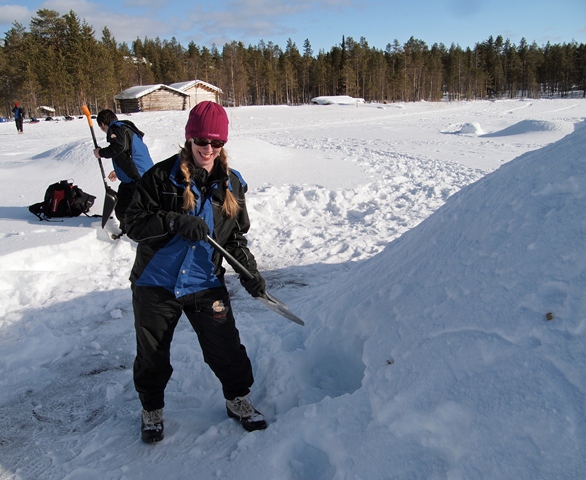
The next photos are a better illustration of the difficulty in clearing snow from a small entrance - you have to work yourself inside and slide it past yourself, while someone outside removes it.
x
Below you can see the finished entrance. We also cleared the snow down to the base of lake ice. Gotta keep up appearances so the neighbors don't complain!
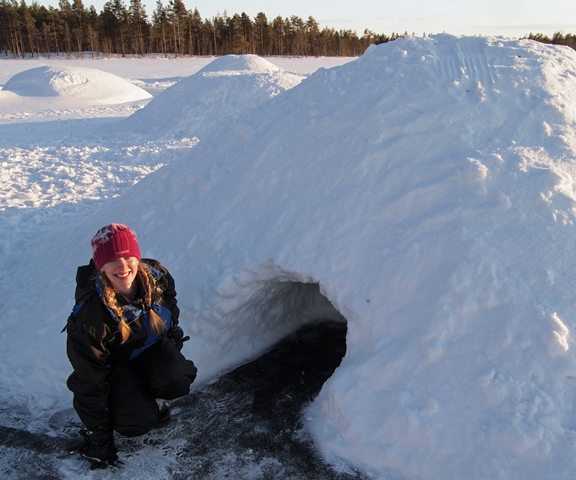
Once you have removed enough snow from the inside to fit a couple of people, the rest goes quickly. Two of us were inside, scraping snow until reaching the ceiling markers (you can see them in the photo below) and the other two were helping remove it through the tunnel. When finished, this is what it looked like shuffling yourself through the entrance. Notice the ramp of snow, up from the ice to the sleeping level. Not only does it help prevent air flow with the outside, but it's more comfortable to sleep on snow vs. ice.
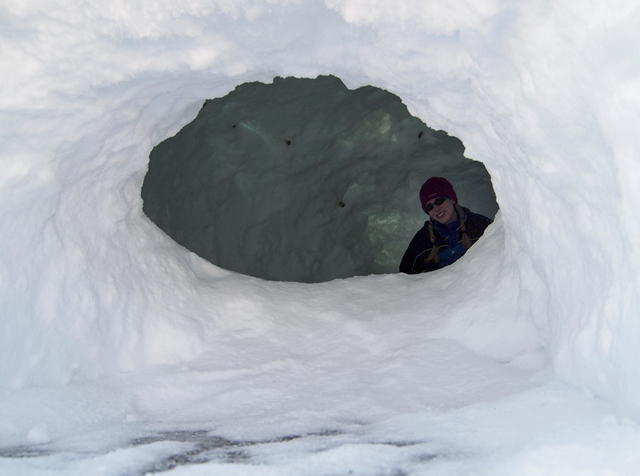
Done! Time for a well-deserved break inside the igloo. The structure did fit four people, but of course is a little cramped. Stray arms and legs invariably send scraped snow falling from the dome above, but overall it worked well.
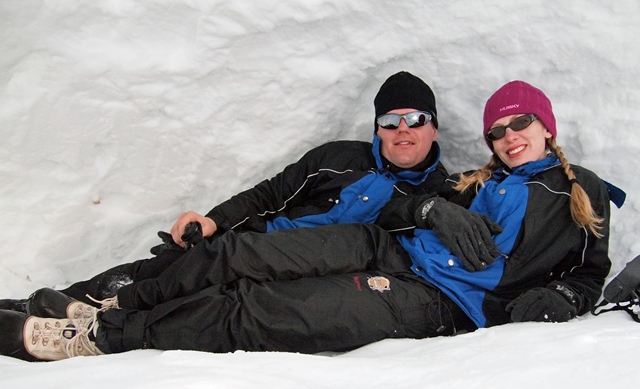
Step 5: Set up for sleep. In this case, we had thermal camping pads underneath warm sleeping bags, and wore winter clothes inside the sleeping bags too. Just our heads were sticking out, and hats stayed on. Headlamps ("head torches" to our UK friends) are very practical -- but you really don't want to have to go the bathroom outside during the night. Inside, it was a consistent 0 degrees C (32 F). Outside, the temperature plummeted to -25 degrees C! (-13 F). The igloo really worked. The main challenge was getting comfortable with the equipment.
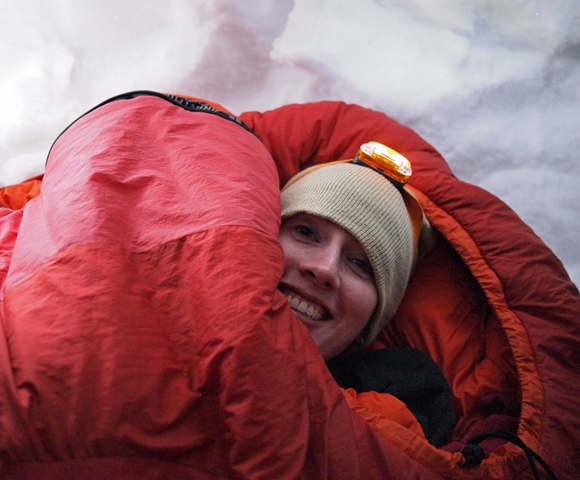
The alarm went off at 7am... it was a great experience. The snow wasn't incredibly comfortable, and one of our partners decided to head inside after a couple of hours. But Frau A, our South African friend, and I stuck it out the whole night. Once the adrenaline dies down and you adjust to the sleeping bag constraint and lying on stiff snow, you can sleep pretty well. The toughest part was leaving the sleeping bags in the morning and heading back to the lodge! It was a great start to a fantastic vacation.
And thanks to our friends Mr. B and Ms. S too!
 Herr J ...
Herr J ...  3 Comments
3 Comments  Travel tagged
Travel tagged  Finland,
Finland,  Oulanka National Park,
Oulanka National Park,  igloo ...
igloo ...  Print Article
Print Article  Email Article
Email Article  Share Article
Share Article 




